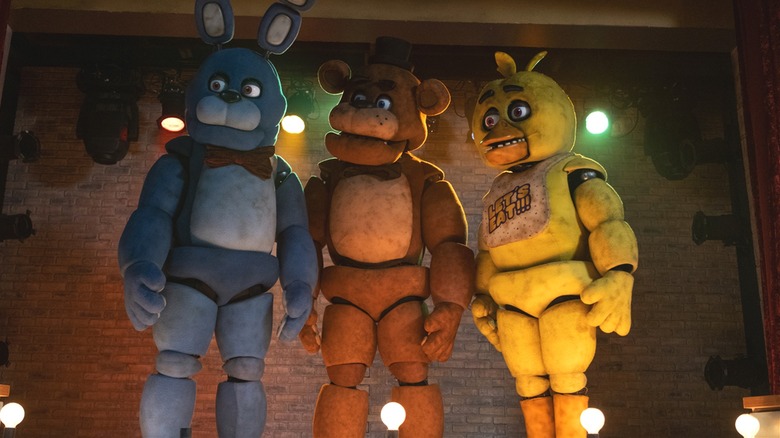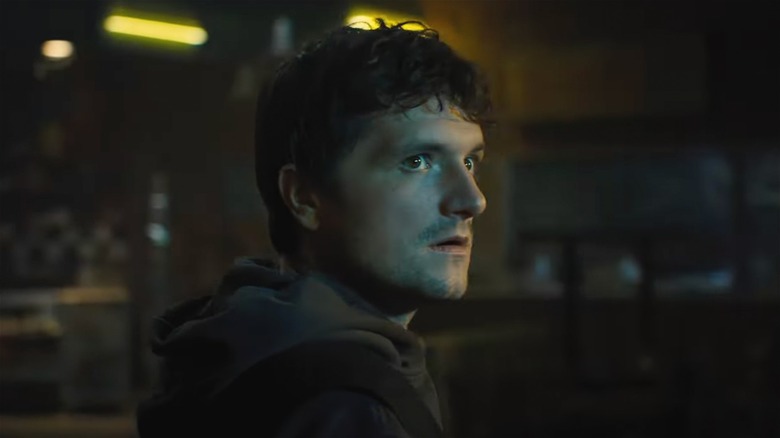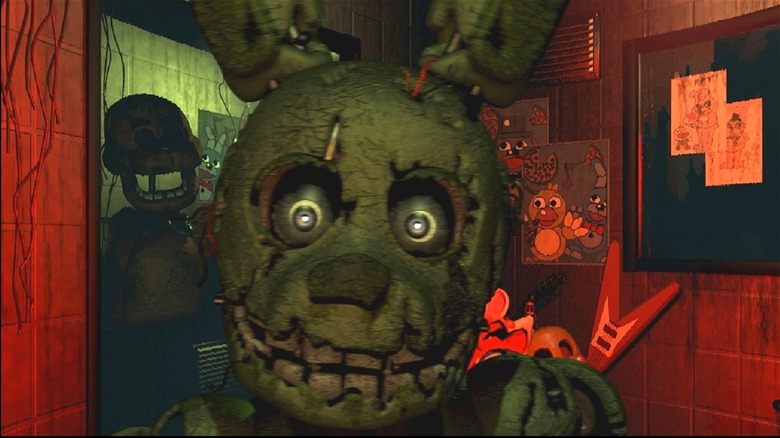Why It Doesn't Matter That The Five Nights At Freddy's Movie Isn't Rated R
The inherent pull of the "Five Nights at Freddy's" (FNAF) video game series is suspense, coupled with the raw fear of what might be waiting for you in the dark. While the core premise of each installment is fairly easy to figure out in terms of objectives, the franchise places particular emphasis on keen observation, spatial awareness, and investment into character attributes. "FNAF" enthusiasts must have been delighted when a film adaptation of the popular video game franchise was announced, followed by a trailer that showcased security guard Mike Schmidt (John Hutcherson) going through the wringer after accepting a job at Freddy Fazbear's Pizza establishment.
Just like players in the game, Mike has to keep track of video camera footage and resolve anomalies that might crop up during his night duty. However, things are more ominous than they seem, as Mike also has to contend with the four animatronic mascots that roam the establishment after midnight. Based on the quality of the trailer alone, it is clear that Blumhouse is attempting to do something special here while making certain tweaks to established "FNAF" rules and lore to ease the transition between mediums. This might evoke concern in hardcore fans, seeing as the franchise's lore is integral to the gameplay and how the world of "FNAF" works. However, it is too early to dissect these concerns, as the film might end up mixing nostalgia with new creative directions in ways that feel exciting.
The film's PG-13 rating might be equally concerning to some, as "FNAF" is essentially a horror-themed game series, where players get ambushed by animatronics when they least expect it. That said, the "FNAF" adaptation does not need to be R-rated, as the games have always relied on atmospheric terror and the power of suggestion to induce terrifying experiences.
Every FNAF experience is unique
There's a reason why "FNAF"-related content tends to perform so well across platforms: it is the kind of game that meshes well with audience backseating, similar to "Outlast" or "Amnesia." Even if you've never played "FNAF," simply watching someone else play it is equally effective thanks to the immersive nature of the gameplay, coupled with the short duration of the games (at least compared to most objective-based games in the genre). Moreover, every "FNAF" experience is potentially unique. For instance, the latest DLC for "FNAF Security Breach," "Ruin," follows the same storyline and timed scares for every player, but the nature of the experience is intensified by the way in which the player chooses to use the V.A.N.N.I security mask (which exposes the player to AR objects and The Entity).
Blumhouse's "FNAF" adaptation might be reflective of the franchise's ethos if done in a faithful manner, which obviously means that some of the deep-seated lore needs to be sacrificed in favor of a more simplified storyline. The film will hold special significance for fans of the games, but even within this community, expectations are bound to shift around based on one's individual exposure to the franchise. Another integral aspect of "FNAF" are the theories surrounding the storyline, which often seems deceptively simple if taken at face value. Case in point: Innumerable fan theories about the perpetrator during The Bite of '87 incident have been put forth, and while it's unlikely that the film will address similar theories exclusively, Easter eggs might be scattered about for good measure.
Circling back to whether the film's PG-13 rating is enough, let's look into the nature of standard "FNAF" gameplay, and why the adaptation doesn't require an R rating to recreate the atmosphere of the games.
FNAF has always been about atmosphere
There are three aspects to standard "FNAF" gameplay: point-and-click advancement, puzzle solving, and objective-based exploration. The horror inherent within these individual situations is the fear of running into something in the dark, and subtle elements are employed to induce uneasiness until it is ramped up to a sudden animatronic jump scare. There are plenty of horror franchises that employ this aspect along with gore — some examples being "Dead Space" and "Resident Evil," where blood and guts are a staple — but "FNAF" has never been particularly violent or bloody.
Instead, it is the premise of being stalked by a creepy animatronic in the dark, and evading them just in time before it's too late, that makes "FNAF" so unnerving. Moreover, aspects of its storyline, such as The Missing Children Incident and The Purple Guy, among others, are employed in a way that feels unsettling, like a looming presence you cannot shake off. The usage of realistic settings, such as a pizzeria that is obviously modeled after Chuck. E . Cheese, or a child's bedroom that feels eerie after nightfall, helps fuel the sense of paranoia during gameplay. This, coupled with the stress of resource management (such as the anxiety-inducing oxygen level mechanics in "Five Nights at Freddy's 3"), is what cements the franchise's reputation as scary and disturbing.
Emma Tammi, who is helming the adaptation, has prior experience dabbling in atmospheric horror, and her feature "The Wind" highlights paranoid frenzy and the overwhelming feeling of being trapped by a setting in spectacular ways. This makes Tammi a natural fit for "FNAF," which is essentially a series of nightmarish experiences strung together to meld into a struggle for survival.
"Five Nights at Freddy's" will hit theaters and stream simultaneously on Peacock on October 27. 2023.


